A look ahead to new and returning comets in 2016.
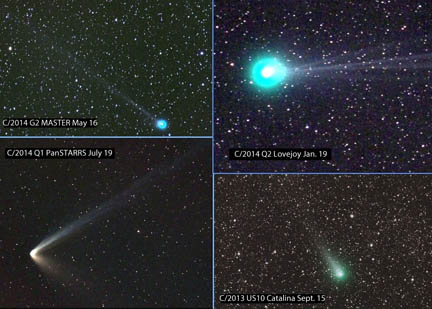
Michael Mattiazzo
A small confession. I wanted the title to read "bright" comets in 2016, but while the coming year has its share of interesting comets, including the bright leftover, Catalina (C/2013 US10), no returning comets are expected to approach the naked-eye limit. Two may climb to magnitude +7, but the others will be at least a magnitude fainter. If there's a bright comet waiting to be discovered, 2016 would be the perfect year for it. Comet lovers will have few distractions.
Pre-driven models
At least we're in good hands going into the new year, with one binocular and two small-telescope comets on offer. Comet Catalina, currently at magnitude +6–6.5 and easily visible in ordinary binoculars under a dark sky, makes a spectacular pass of the brilliant star Arcturus on New Year's Day. Friday morning around 6 a.m. CST (12:00 UT), the twin-tailed comet will zip less than 1/2° west of the star, clipping along at nearly 2° per day (4.5′ per hour).
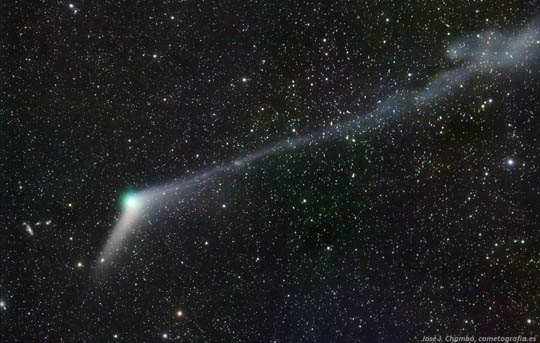
José J. Chambó Bris
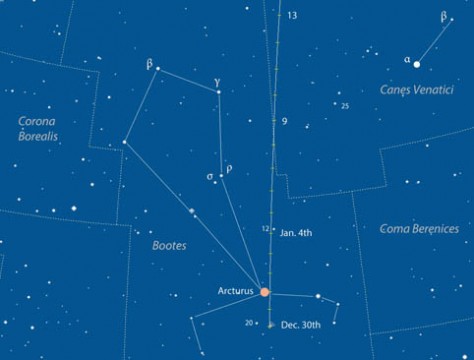
Chris Marriott's SkyMap
When viewed through a small telescope, the comet's motion should be obvious within 15 minutes. A last-quarter moon in nearby Virgo may spoil the view just a bit, but the strongly-condensed coma and a hint of a chubby dust tail should still be visible in a 6-inch scope.
Catalina is expected to remain near 6th magnitude through mid-January and then gradually fade. Closest approach to Earth occurs on January 17th at a distance of 67.4 million miles (108.4 million km).
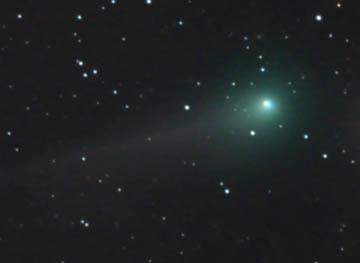
Damian Peach
PanSTARRS (C/2014 S2), discovered with the PanSTARRS-1 telescope atop Mt. Haleakala in heavenly Maui, will be vacationing in Draco this winter as it slowly fades from its current peak brightness of magnitude +9. Even a 4-inch telescope will show the comet's small, 3′ wide, slightly elongated coma. C/2014 S2 is out at nightfall low in the northwestern sky, or higher in the northeastern sky before dawn.
Naked-eye potential?
Looking for a reasonably bright, easy-to-track evening comet? PanSTARRS (C/2013 X1), a well-condensed 9th-magnitude object with a faint tail fanning northeast, crosses the Great Square of Pegasus over the next few weeks. Standing near the meridian at the end of evening twilight, this bit of ice-speckled fuzz extends an invite under the moonless skies of early January.
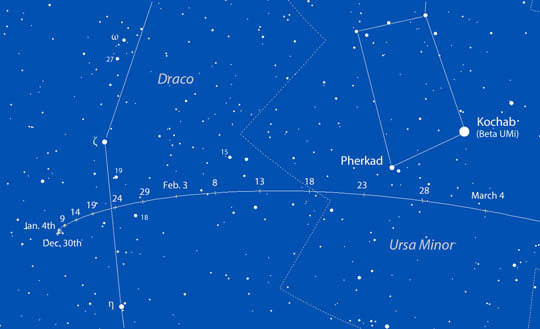
Chris Marriott's SkyMap
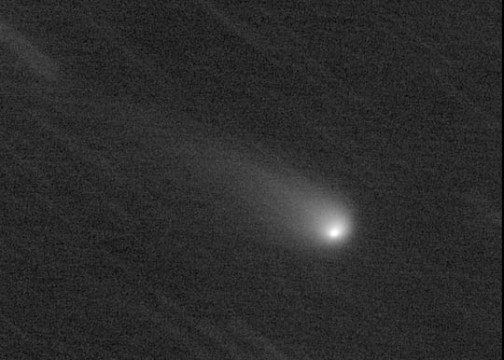
Adriano Valvasori
C/2013 X1 slowly brightens as it heads toward solar conjunction in mid-March, returning to view very low in the pre-dawn sky in Aquarius in mid-late May. For the next month, it steps across Aquarius, Piscis Austrinus, and Microscopium before sinking below the southern horizon for viewers at mid-northern latitudes. Before disappearing from view, C/2013 X1 could glow as bright as magnitude +6.5. Southern hemisphere observers will be favored throughout the apparition, especially when the comet reaches peak brightness in June and early July.
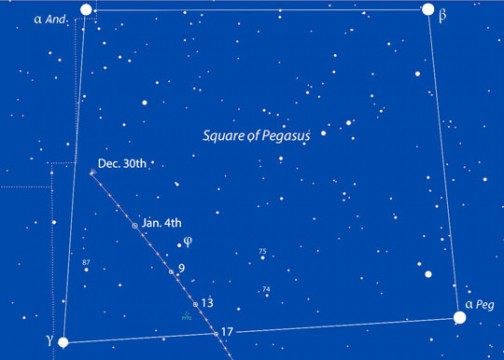
Chris Marriott's SkyMap
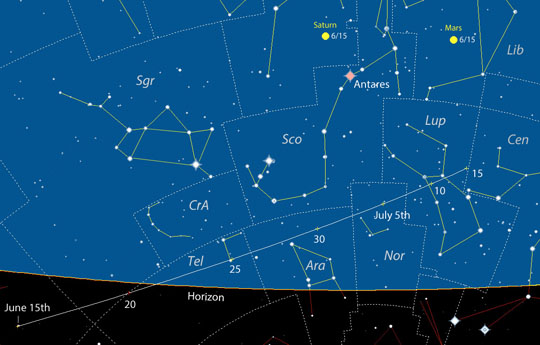
Chris Marriott's SkyMap
Periodically yours
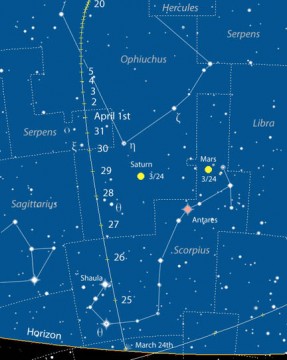
Chris Marriott's SkyMap
252P/LINEAR is one of the many comets discovered by MIT's Lincoln Near Earth Asteroid Research (LINEAR) survey. This small object returns every every 5.3 years; this time around, it will make an exceptionally close approach to Earth, passing only 0.36 AU or 3.35 million miles from your rooftop on March 21st.
Depending on what set of orbital parameters you choose, this is either the 5th or 6th closest recorded comet flyby. Some of you may remember Comet IRAS-Aracki-Alcock (C/1983 H1), which powered from one end of the sky to the other in 3–4 days, passing just 0.031 AU (28.8 million miles) from the planet on in early May 1983. What an incredible sight it was in the telescope: the fast-moving pinpoint nucleus, bright inner fan, and monster-sized coma.
While you'll have to routinely nudge your scope to keep pace with 252P/LINEAR as some of us did with C/1983 H1, it's only expected to reach magnitude +9 or 10 when brightest in mid-to-late March in the morning sky. For northern observers, the comet's period of visibility begins in late February, low in the southern sky in Columba, the Dove, when it might glow weakly around magnitude +13. Catch this one quickly because it's rapidly scooting due south and will soon be lost from view.
Brightening rapidly, Comet 252P tears across Mensa, Octans, and Apus at the rate of nearly 10° per day in mid-March, until it pops up in the tail of Scorpius on March 25th before the welcoming eyes of northern skywatchers. Now heading north in a hurry, the comet climbs into Ophiuchus for all to see. Like the TV celebrity of the moment, Comet 252P's rapid rise to fame will be followed by an equally steep decline.
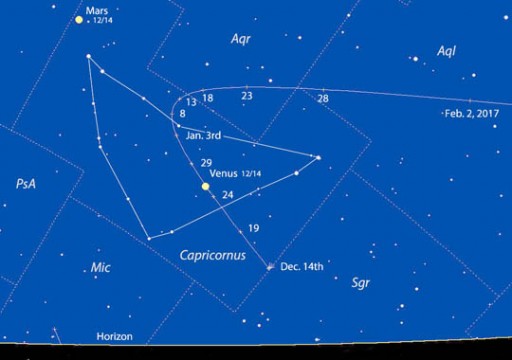
Chris Marriott's SkyMap
Another periodic comet, 45P/Honda-Mrkos-Pajdusakova, ends the year with a flourish. Although faint and far south of the celestial equator in November 2016, it climbs into Capricornus low in the southwestern sky in mid-December. This is one of the comet's closer approaches to Earth, so expect it to brighten to magnitude +7 (easy binocular visibility) around the time of its December 31st perihelion. Comet 45P, discovered by Minoru Honda in December 1948, typically remains faint until near perihelion. It's a tiny comet with a nucleus only about 0.5 miles (0.9 km) across, some four times smaller than 67P/Churyumov-Gerasimenko, Rosetta's comet.
Iffy Stuff
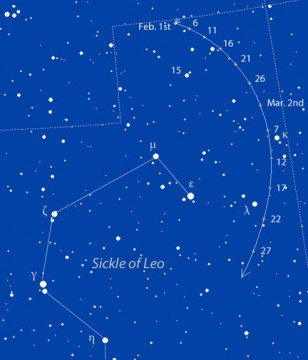
Chris Marriott's SkyMap
Two comets with big question marks remain: Ikeya-Murakami (P/2010 V1) and 226P/Pigott-LINEAR-Kowalski. No one's seen Ikeya-Murakami yet despite a predicted magnitude of +12. It's way behind schedule, but comets, especially returning ones, sometimes don't brighten up until perihelion or shortly after. Assuming it rallies, P/2010 V1 could reach 8th magnitude in late February and March, when it will be perfectly positioned for evening viewing in Leo. Perihelion occurs on March 10, 2016. I've included a chart just in case the comet shows.
Edward Pigott of York, England, discovered Comet 226P in November 19, 1783, so long ago that Charles Messier himself observed it. So did William Herschel and Messier's deep-sky collaborator, Pierre Méchain. Author Gary Kronk, in his Cometography series, describes Messier's observations of Pigott's Comet: "(he) first saw the comet on the 27th and said that, while the comet was not visible to the naked eye, a refractor revealed an extremely faint nebulosity about 4′ across. He noted a strong central condensation."
I'm intrigued by Comet 226P because it connects us to the lives of the early astronomers, especially the "comet ferret" himself, French astronomer Charles Messier, who discovered some 20 comets of his own and observed 44 over his lifetime.
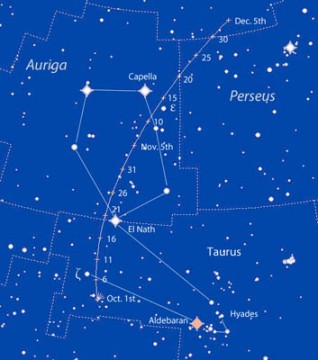
Chris Marriott's SkyMap
Pigott's comet may climb to 10th magnitude in October and early November as it glides northward from Taurus into Auriga. This according to some predictions. But during previous recoveries, the comet was very faint — two planetarium programs I used and JPL's HORIZONS system all show a peak magnitude of +15–17 when brightest in October and November 2016.
Will it show? Let's hope for surprises ... and new discoveries. Happy Fuzzball New Year!
 1
1








Comments
Wayne-Wooten
January 10, 2016 at 2:58 pm
Watch the decimal point. Comet IAA passed less than three million miles from us. We could see its motion in just minutes when it passed by the Beehive cluster. My wife Merry took some neat photos of its rapid motion in May 1983.
You must be logged in to post a comment.
You must be logged in to post a comment.